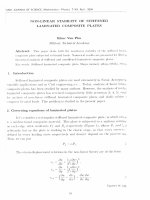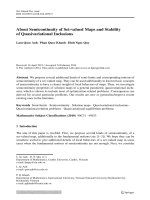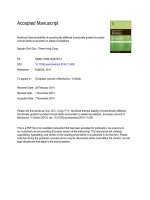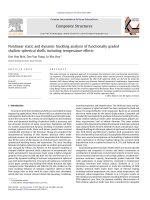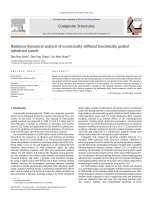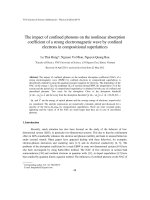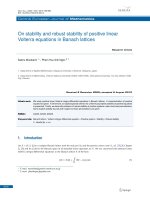DSpace at VNU: Non-linear stability of stiffened laminated composite plates...
Bạn đang xem bản rút gọn của tài liệu. Xem và tải ngay bản đầy đủ của tài liệu tại đây (2.58 MB, 8 trang )
VNU
J O U R N A L O F S C I E N C E , M athem atics - Physics. T.xx, N()4 - 2004
N O N -L IN E A R ST A B IL IT Y O F S T IF F E N E D
L A M IN A T E D
C O M P O S IT E
PLATES
K h u c Van P h u
Military Technical Academ y
A b s tra c t.
This paper deals with the non-linear stability of th e stiffeiK'd lai.ilt(
composite plate su b jected to biaxial loads. Numerical results are presented for illutr ii
theoritical analysis of stiffened and unstiffened lam inated co m p o site plates.
Key words. Stiffened lam inated com p osite plate, Shape m em ory alloys (SMA), stbity
1. I n t r o d u c t i o n
Stiffened laminated composite plates are vised extensively in Naval, Aerospao.Vi
tomobile applications and in Civil engineering,v.v... Today, analysis of linear laiditi
composite plates has been studied by many authors. However, the analysis of noj-liei
laminated composite plates has received comparatively little attention [3, 4, 5]. sjedl]
tor muilysis of noil-linear stiffened laminated composite plates and shells subjoti 1
compress l)i-axial loads. This problem is studied in the present paper.
2. G o v e r n in g e q u a t i o n s o f l a m i n a t e d p la te s
Let’s consider a rectangular stiffened laminated composite plate, ill which call y (
is a unidirectional composite m aterial. This plate is subjected to H uniform coin)(^i(
o i l Vcich edge, with result ants p , and Py respectively (Figure 1 ), where p x and 'y ai
arbitrarily but as the plate is working in the elastic stage, so that every stress tf‘
defined by every loading sta te respectively and doesn’t depend on the process >an
Thus, we can put
Py = O P , .
Th(‘ Strain-displacement, relations in the non-linear theory are of the form
T y p e s e t by
33
34
K h u c Van P hi
kx =
d2w
d 2 IV
ky ~
ỡy2 ’
Ỡ2 W
k Xy — —2 7
where a, V.
w
are the midplane displacements along the
X, y
and z axes respectively.
7
S2
Zl
X
f
Y
ỌI
N
Fz # . 1
Integrating the st.ress-stra.in equations through the thickness of plate we obtain the
expressions for stress resultants and flexion moments:
N x — { A l l 4- E \ A \ / S \ ) e x 4- A i 2 £y 4- { E \ A \ / S i ) z \ k x 4- p ^ / s 1 ,
N y = ( A 2‘ 2 4- E 0 A 2 / S2 )Sy + A \ 2 EX + ( E 2A 2/ S 2) z 2ky -f P y / s o,
^1*1/ — ^4f) (Slxy,
(3)
M e — (£>11 + f ii /i/5 i) f c « 4- D i2ky
4- ( E i A i / $ i ) z i £ x i ,
M y = ( D 2 2 + E 2 I 2 / so)ky 4- D i o k x
+ ( E 2 A 2 / S2)z2Sy,
Mxy — Dị-t(\h’Xy i
where
-
Dij ( i j
=
1 ,2 and 6) are e x te n d in g and b e n d in g stiffn esses of th e plate
without stiffeners,
- Ei: E 2 are the Young modulus of the longitudinal and transversal stiffeners
respectively,
N o n - lin e a r s ta b ility o f s t i f f e n e d la m i n a te d c o m p o s ite p la te s
35
- A\. A o cire the section areas of the longitudinal and transversal stiffeners. respec
tively.
- 1 1 In
are the inertial moments of cross-section of the longitudinal and transversal
St iffoners, respectively,
- ,sI , .s2 are the distances between two longitudinal stiffeners and between two
transversal stiffenors. respectively,
Z o are the distances from the mid-plane to the centroids of the longitudinal
and transversal stiffeners, respectively,
- IP r.
' , lP'\ are m
thee recovery rensiie
tensile iorce
force 111
ill rile
the OIVI/V
SMA wires.
VVIIt'b.
The equilibrium equations of a plate according to [2] are
ONr
, d N xy
Ox
Oy
^
OX
o 2M r
0~I\I,I ỊI
d 2M y
0 2w
- —-7— 4 - 2 - —- H---- T—7T 4- iV;r- —r -f
ỡư:2
Oxỡy
ỡy2
dx2
- 0.
(4)
ay
n
d 2w
d 2w
d 2w
ơ 2m
XỊJ — + iv y — 5- + 7 :r — Ộ + i yTTT —
ởxỡy
dy2
Ox 2
dy2
Substituting (2) and (3) into (4) after some operations we obtain the equilibrium
equations of the lam inated plate
(An +
+ 1^ 12
12 + A ° ^ ddxx dd yy ~
/Sl w
+
, s d u ) d 2w
, A
A s d w d 2w
. d w d 2w
A \ / s i ) - — ——^ -f (A 12 + ^Gf)) — 7T“77— -Aogtj—T p r
G>:r y.T2
dy d x d y
u x ay-
+
(Ao2 4 - E o A - ỉ / so ) ^ ^ +
+ (^12 + ^60)77-77----- (^2^2/^2)2:277-^ +
v
7
ỡy 2
Ỡ;/
J Oxay
OIJ
„ 4
xd w d 2w
tA
A , d w d 2w ,
d w d 2w
+ ( A 22 4- E 0 Ả 2 / Sn) — 77 Õ" + (^12 + ^OGyTT- o 0 + ^66
o o — Uv
7 J dy ở y 2
' dx dxdy
ay dx-
( D u + E i / i / . S i ) ^ ^ + 2 ( Ơ 1 2 + 2D(ifi) - ^ 2 Q^ 2 + (£*12 + £ '2/ 2 / S2) ỹ ^ 4 ' _
^ 7 2 - ( p v + p y i ^ h f ~ ( E i A 1/ s 1) z 1^
-
- ( E 2A 2/ . s2) z 2 ị ^ ~
Oiu d :i tu
, , d w d 3w
1 .
„
- ( E l A l / s 1 ) z 1i^ ^
- (E 2A 2/ s 2 )z2^ ^
- ụAn +
. ,
D2w f d i v \ 2
Q2 w ( d w \ 2
1 0 2w ( d w \ 2
1
d 2w ( d w \ 2
“T o ( .
) - ^ 12 T T h r
- 0 ( ^ 2 2 + E 2A 2 s 2 ) ^ - y (
I 2
ỡy2 Vy .r)
2
Ớ.7;2 V d y J
2
dy Vd y )
A Ow du) 0 2 w
, Vd u d 2w
On d 2w d u d~w
2 Aq6 —— 7-——
—— — (-All + E \ A \ / s 1) — — 2" —2 ^4(56 n 0 0
^12 fj o o
ÔX d y d x d y
Ox d x 2
dy d xd y
ỜX UIJ
1
- - ^
d v d 2w
12 dy Ox 2
dv d w
" 66 Ỡ£ d x d i
r-,
A
/
X9 v d 2 W
(Aoo -f- E o A o / s o ) —— _ 9 — 0-
ỠU d i r
36
K h u c Van P h u
For a plate simply supported on all edges, the following boundary conditions are
imposed
-f At edges X = 0 and X = a
w = 0,
V — 0,
M x = 0;
(6)
u = 0,
M y = 0;
(7)
+ At edges y = 0 and y = b
w = 0,
The boundary conditions discussed here can be satisfied if the buckling mode shape
is represented by
_
nny
rriTTX
u = u mn COS —
a
V =
sin —- -
T. rriTTx
V m n s ill —
TITTV
COS
a
Jir
■ m7TX
w = w rnn s ill
—
,
b
a
,
(8 )
bv1
nny
.
sin
—-— ,
b
where
- a, ft : edges of plate ill X and y axial directions respectively,
- m, n : the numbers of halfwave in the X and y axial directions respectively.
Substituting expressions (8) into the equilibrium equations ( 5 ) and applying the
Galerkin procedi ice yield the set of three algebraic equations with respect to the amplitudes
u,nn, Vnnii w mn, where th e first two eq u ation s o f th is s y s t e m are linear algebraic equations
foi umm V-mn
(l\ U tmi + O2 V 11U1 — (l,\W mil 4- (1 4 W ~Lfl,
(9)
a!jUinn + fleKnn — ^ W i n n "f Cl%W^lxrx,
Getting from (9) expression t/mn, Knn with respect to w mn and substituting into
third equation of (5) we obtain a non-linear equation with respect to w
•
a 9W^lw + a i 0W?nn 4- ( a n 4- XPx )W inn = 0,
( 10 )
where a, are coefficients which depend on the material, geometry and the buckling mode
shape.
i A 1—
' A /
\ m2b
a i — (All + E \ A \ / S \ ) —■
— h A 66
a
0*2 = &5 = ( A \2 -f A ẽo)m n,
„2 _
rra
b '
_ / El 4 , \ m 3nb
— {E\A\/S\)z\
a2
16
2 ( ^ n +£7 1 v41/ S l) ( — )) 2-— - (A 12 - A m ) ~
a //* ỈĨ7T
/77Ĩ
\ (I
l)7T
7n 2b
4
(lQ — (A 22 4- E 0A 2/ S2) - J - + L66
,
0
a
“4 = - y
^
„
_
/
,
n
A
/
\
n
a
A
m
2
b
Ò2
16
08
9
2(^22 + E 2A 2/ s 2) ( j ) 2 - ^
\b /
rriTT
- ( A n - A (M) ~
'an.
N o n - lin e a r s ta b ility o f s t i f f e n e d la m i n a te d c o m p o site p la te s
a9
( - A l l + jE’i A i / s i ) — 3- 4- 2 ( ^ A \ 2 +
2^
66) “— ~b~ +
( ^ 22
37
+ ^
2^ 2/ 52 ) - p
/ / i ( g 6a4 - Q2fl8) -í- H 2 (fi-1^8 - ^ 5^ 4)
a i a 6 — «2^5
9 [(jElA l/Sl)2l( ? ) 3^
flio
-f
+ ( ^ A 2/ s 2)z2( ^ ) £ ^ j +
H \ (a.ịO.ịị — Ci2a ĩ ) + / / ‘2 (a i a 7 — a 3a ĩ>) + H^(ãQã4 —
a i a e — a2ữ5
Try^
an
4- / / 4( ^ 1^,« — (1 5 (1 4 )
f77777Ì ^
( D l l + ^ l A / s i ) — 3 — I" 2 ( L >12 + 2 D q q ) ----- ------ h ( - D 22 +
_ _Tỏ(I
E 2 I 2 I S 2 ) —g f +
/ / 3(a3a6 - a 2a 7) + #4(ai&7 - a 3a 5)
aựiG — a2«5
n 2a
1 / m 2b
A
4 Va7T2
+ a
)■
16
Ỵ - ) - ^ 3 ( i 4 1i + J 5 i ^ i/ 5 i ) + (i412 + 2A66) | ^
tm
~9~ A a / n7T:i
16
1G r r n \ 2
a / A
n
A /
\
i A
n A
\ 771 '
H 2 = - n ( u ) ~^3 ^ ( ^ 22 + E 2A 2/S 2) H~ (^12 + 2^4fiei) —
—9 LVb / 77Ì7T3
a7T;i J
Hi =
1 ,„ . , ,
m 36
# 3 — —- ( £ i > W s i ) z i 2 ,
4
tt 7T
1 .„
,
.
.
n 3a
H 4 = —- ( E 2 A 2 / s o ) z 2 ~7Tf
4
I r 7Ĩ
•
From (10) we can express compression load with respect to H^mn as follows
p* = V(Wmn)
( 11)
The lower buckling load of the plate can be analysed by the minimum of
ỠR
= 0.
(12)
a w mn
Tho value of W m n corresponding to the lower buckling load is found from the
equation (12) and then substituting into equation ( 1 1 ) we obtain lower buckling load P x .
We can determine the minimum critical buckling force P x min by the way of varying
777,, 7Ĩ
and
P y m in — OlP
x
m ill*
3. N u m e r i c a l e x a m p l e s
Let’s consider a simply supported stifferned rectangular symmetrical composite
plate: a = 0.8 m; Ò = 0.5 m;
The materials of the plate have Thornel 300 graphite fibers and Narmco 5205 T her
mosetting Epoxy resin [5], the properties of these materials are
3
K h u c Van P hu
El = 127.4 GPa; Ẽ 2 = 13GPa; Ơ 12 — 6.4 GPa; Z^12 — 0.38;
- The plate has six layers: [45/ - 4 5 /9 0 /9 0 / - 45/ 45];
- Thickness of each layer: t = 0.5 mm;
- The la m in a te p la te is reinforced by lon gitu d in al and trains versa] stiffeners, which
na.de of CPS, SMA and combined materials. In combined case: longitudinal and
taisverse stiffeners are SMA and CPS material respectively;
Tablcl. Effect of thickness of the plate (W ith a = 1 )
Critical buckling loads Px (.N / m )
h/b
4,2.lO-3
6,0. 1 0 -3
7 8 .1 0 - 3
9,6. 1 0 -3
11,4.10-3
13,2.10—3
1 5 , 0 . 1 0 - :i
16,8.10-3
Unstiffeners
CPS
Stiffeners
SMA+CPS
Stiffeners
SMA
Stiffeners
2.8155e+003
8.2084e+003
5.6321e+003
1.3027e+004
2.544 le+004
4.4277e+004
G.1798e+008
6.1799e+008
6.1800e+008
6.1802e+008
6.1805e+008
G.1808e+008
6.1813e+008
6.1819e+008
2.2000e+009
2.2000e+009
1.8034e+004
3.3622e+004
5.6302e+004
8.7404C+004
1.2826C+005
1.8019e+005
7.0943e+004
1.0G84e+005
1.5338e+005
2.1196e+005
The stiffeners have the same sizes, as follows:
Diameter of SMA wire is: d = 1.2
X
bg X h g
2.2000e+009
2.2000e+009
2.2001e+009
2.2001O+009
2.2001O+009
2.2002e+009
= 4 mill x 6 mm:
10 ~ 3 m;
Spacing OÍ longitudinal and transverse stiffeners are: Si =
.S'2
= 0.1 m.
Table. 2 . Effect of orientations of the plate (W ith a = 1 , CPS Stiffeners'
The stacking Sequence
Critical buckling loads Px (N / r n )
30/-45/90/90/-45/30
0 /9 0 /0 /0 /9 0 /0
45/-45/0/0-45/45
60/-45/30/30/-45/60
45/-45/90/90/-45/45
0.93695e+004
0.93939e+004
0/-45/90/90/-45/0
1.1554e+004
1.2680e+004
1.3027e+004
1.3599c+ 004
N o n - lin e a r s t a b ility o f s t i f f e n e d l a m i n a te d c o m p o site p la te s
Table 3. Effect o f tran sverse stiffeners oil critical buckling loads
(W ith a = I)
Spacing
0.05
0.1
0.15
0.2
0.25
0.3
0.35
0.4
0.45
0.50
Critical buckling loads Px (N/rri)
CPS Stiffeners
CPS + SMA Stiffencrs
SMA Stiffcner:
1.6967e+004
1.3027e+004
1.1661e+004
1.0967e+004
1.0547e+004
0.1822c+008
6.1819e+008
6.1818e+008
6.1818e+008
6.1817e+008
G.1817e+008
6.1817e+008
6.1817e+008
6.1817e+008
6.1817e+008
3.7822e+009
2.2002e+009
1.6728e+009
1.4092e+009
1.2510c+009
1.1455e+009
1.0702e+009
1.0137e+009
1.0266e+004
1.00G4C+004
9.9128e+003
9.7947e+003
9.7000e+003
9.6972e+008
9.3456e+008
4. C o n c lu s io n s
When considering non-linear geometry of laminated composite plate reinforcedb
stiffeners, we obtain:
+ Critical force of CPS laminate plate not reinforced by stiffeners:
Px min = 8.2084e 4- 003JV/m;
4- Critical force of CPS laminate plate reinforced by CPS stiffeners:
p ,:min = 1.3027e + 004N/m;
+ Critical force of CPS laminate plate reinforced by SMA and CPS stiffeners:
Pj-I nil. = 6.1799c + 00SN/ m]
■f Critical force of CPS laminate plate reinforced by SMA stiffeners:
P * min = 2,2002e + 009JV/m;
Critical force of the plate being reinforced by S M A stiffeners is higher than th it t
CPS stiffeners.
The plates, which are reinforced by SMA stiffeners work more stably than tioe
of CPS stiffeners (Fig. 2) when geometrical parameters of plate are varied. In the ae
of plates under biaxial compression, the siffeners will influence strongly oil the C11 K.1
force(Fig. 3).
K h u c Van P hu
^0
Fig. 2. Effect
of
dimension
OI1
critical loads (with a = 1)
•V •if
.•
t
big. 3.
Effect of longitudinal stifteners on critical buckling loads (w ith 0 = 1 )
Depending oil arranged layers of the plate, we can receive different critical buckling
01C(. Ill this exam p le, w<‘ received m in im u m critical b uckling force corcssponclinc to the
,a>e [3 0 /-4 5 /9 0 /9 0 /-4 5 /3 0 J .
V £ k n o w l6 d g 6 m 6 n t s . Ỉ he an ther w ould like t o tbrink Professor D ho Huy Bicli for helping
lim to complete this work. This publication is partly supported by the National Council
01 Natural Sciences.
References
1. Tian leli riiinh, Composite Materials - Mechanics and Calculation of Structures.
Ed. Education, (1994) (in Vietnamese).
2. S. P. Timoshenko, J. M. Gere, Theory of Elastic Stability. Science and Technical
Publisher, (1976) (ill Vietnamese).
ỉ. M. w . Ilyer, Stress analysis of fiber Reinforced Composite materials. McGraw-Hill.
International Editions, (1998).
L M. Kolli and K. Chanclrashckhara, Nonlinear static and dynamic analysis of stiffrnod laminated plates. Int. J. Non-linear Mechanics, Vol.32, Nol(1997) pp. 895 Victor Birman. I heory anil comparision of the effect of composite and shape mem
ory alloy St iffrners Nability of composite shells and plates, Int. ,J. Mech Sri
Vol.39. XnlO. pp,M39 1149
